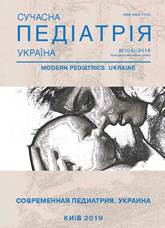The kidney complication of upper respiratory tract infection in preterm child of breast-feeding age
Keywords:
kidney disorders, preterm child of breast-feeding ageAbstract
The causes of children's morbidity and remote consequences are an important issue of the modern pediatric science. Taking into account the anatomical and functional features of premature infants, they need of a multidisciplinary approach in order to care and treat them. We suggest that the spreading of the clinical experience is helpful for the pediatric community to improve the practical skills and theoretical knowledge of the physicians. On the other hand, renal diseases are important causes of morbidity and mortality in children worldwide. Children born early or who are small for date newborns have relatively increased risk for the development of kidney injury later in life. They are often treated with medicines potentially inducing renal tissue injury.In this paper, we have reporter a case in which 8-month-old child presented with a renal violations. The child had renal borderline states in the newborn period of the life. The breast-feeding was short. The respiratory support and warm protection were needed after birth. The physical development was estimated according to the Fenton chart due to 50 weeks of adjusted age of newborn. It was in the borders from 10 to 90 percentile. Fever, vomiting, dehydration and loss of bodyweight and oliguria appeared in the 8-months-old baby after the upper respiratory tract infection. General examine of patient showed the stigmas, delaying of neuropsychological growth, physical growth violations. Tests of blood identified anemia of the first stage and rapidly increasing of the level of white blood cells with the shift on the left the leukocyte formula and dyselectrolyte disorders in the blood. The laboratory tests of primary and secondary hemostasis were normal. The urine test showed a lot of changes of physical and chemical and also microscopic urine's properties. The sonography investigation diagnosed changes of renal tissue too and hyperplasia of the thymus. According to the data of patient's investigation acute urine tract infection — acute pielonephritis — was diagnosed and treated. That is why, physicians should focus attention on the stigmas, delaying of neuropsychological growth, physical growth violations and particulars of run neonatal and breast-feeding period of life, clinical signs and the results of additional investigations in order to get timely diagnosis.
Investigations were made according to the Declaration of Helsinki. The report of investigation was approved by the Local ethical committee of the institution. Informed consent was received from parents in order to make investigations.
References
Abraham G, Gupta RK, Senthilselvan A, van der Meulen J, Johny KV. (1989). Cause and prognosis of acute renal failure in Kuwait: A 2-year prospective study. J Trop Med Hyg. 92: 3250329.
Anochie IC, Eke FU. (2005). Acute renal failure in Nigerian children: Port Harcourt experience. Pediatr Nephrol. 20: 1610—1614. https://doi.org/10.1007/s00467-005-1984-8; PMid:15947980
Cerd J, Lameire N, Eggers P et al. (2008). Epidemiology of Acute Kidney Injury. Clinical Journal of the American Society of Nepherology. 3(3): 881—886. https://doi.org/10.2215/CJN.04961107; PMid:18216347
Fanos V, Antonucci R, Zaffanello M Nenatal. (2012). Drug Induced Nephrotoxicity: Old and Next Generation Biomarkers for Early Detection and Management of Neonatal Drug-Induced Nephrotoxicity, with Special Emphasis on uNGAL and on Metabolomics. Current medicinal chemistry. 19(27): 4595—4605. https://doi.org/10.2174/092986712803306439; PMid:22876902
Fenton TR, Kim JH. (2013). A systematic review and meta-analysis to revise the Fenton growth chart for preterm infants. BMC Pediatrics. URL: http//www.biomedcentral.com/147102431/13/59. https://doi.org/10.1186/1471-2431-13-59; PMid:23601190 PMCid:PMC3637477
Harrison Pam. (2019). Premature Birth Ups Risk of Kidney Disease Into Adulthood https://www.medscape.com/viewarticle/912738.
Ingelfinger Julie R, Kalantar-Zadeh Kamyar Franz. (2016). Averting the legacy of kidney disease: focus on childhood. Journal of Nephrology. 29(2): 137—142. https://doi.org/10.1007/s40620-016-0270-0; PMid:26960419 PMCid:PMC4792345
Jha V, Chugh KS. (1997). Acute renal failure in the tropics. J Assoc Physicians India. 2: 18—23.
Liano F, Pascual J. (1996). Epidemiology of acute renal failure: A prospective, multicenter, community-based study. Madrid Acute Renal Failure Study Group. Kidney Int. 50: 811—818. https://doi.org/10.1038/ki.1996.380; PMid:8872955
Muoneke VU, Una AF, Eke CB. (2016). The Burden and Outcome of Pediatric Renal Admissions at the Federal Teaching Hospital Abakaliki: A 3-year Review (2011—2013). Annals of medical and health sciences research. 6(4): 243—250.
Noronha IL, Schor N, Coelho SN, Jorgetti V et al. (1997). Nephrology, dialysis and transplantation in Brazil. Nephrol Dial Transplant. 12: 2234—2243. https://doi.org/10.1093/ndt/12.11.2234; PMid:9394305
Polin Richard A, Spitzer Alan R. (2011). Fetal and neonatal secrets. Moskov: Bynom.
Seedat YK, Nathoo BC (1993). Acute renal failure in blacks and Indians in South Africa: Comparison after 10 years. Nephron. 64: 198—201. https://doi.org/10.1159/000187314; PMid:8321351
Seedat YK. (1993). Acute renal failure in the black population of South Africa. Int J Artif Organs. 16: 801—802. https://doi.org/10.1177/039139889301601201; PMid:8175192
Srivastava RN, Bagga A, Moudgil A. (1990). Acute renal failure in north Indian children. Indian J Med Res. 92: 404—408.
Waikar SS, Curhan GC, Wald R, McCarthy EP, Chertow GM. (2006). Declining mortality in patients with acute renal failure, 1988 to 2002. J Am Soc Nephrol. 17: 1143—1150. https://doi.org/10.1681/ASN.2005091017; PMid:16495376
World Health Organization. (2012). Recommendations for management of common childhood conditions. http://www.who.int/about/licensing/copyright_form/en/index.html
Xue JL, Daniels F, Star RA, Kimmel PL et al. (2006). Incidence and mortality of acute renal failure in Medicare beneficiaries, 1992 to 2001. J Am Soc Nephrol.17: 1135—1142. https://doi.org/10.1681/ASN.2005060668; PMid:16495381
Downloads
Issue
Section
License
The policy of the Journal “MODERN PEDIATRICS. UKRAINE” is compatible with the vast majority of funders' of open access and self-archiving policies. The journal provides immediate open access route being convinced that everyone – not only scientists - can benefit from research results, and publishes articles exclusively under open access distribution, with a Creative Commons Attribution-Noncommercial 4.0 international license (СС BY-NC).
Authors transfer the copyright to the Journal “MODERN PEDIATRICS. UKRAINE” when the manuscript is accepted for publication. Authors declare that this manuscript has not been published nor is under simultaneous consideration for publication elsewhere. After publication, the articles become freely available on-line to the public.
Readers have the right to use, distribute, and reproduce articles in any medium, provided the articles and the journal are properly cited.
The use of published materials for commercial purposes is strongly prohibited.

